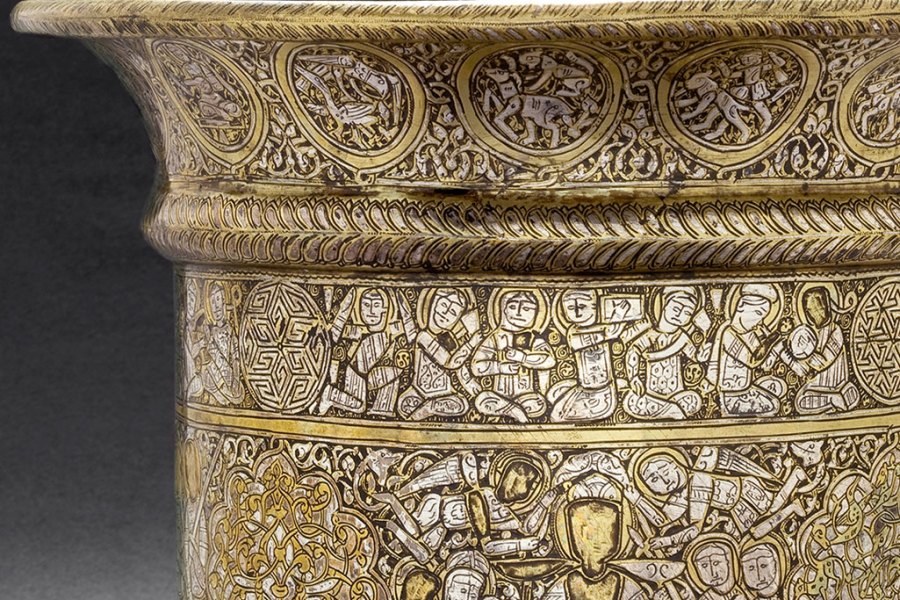Just who was the 11th-century Persian royal poet Manuchehri Damghani referring to when he wrote this: ‘We’re men of drinking, feasting and singing. Hurray for the rebab [stringed instrument], kebab and wine!’? He was describing the cultured, if indulgent, lives of his Seljuq and Turkish rulers whose empire stretched – with periodic fragility – from the Mediterranean eastwards the whole way across today’s troubled region of Turkey, Syria, Iran, Iraq, Afghanistan and beyond to the borders of China. The Metropolitan Museum of Art’s show ‘Court and Cosmos: The Great Age of the Seljuqs’ brings to life that little-known world and is timely indeed. As the museum’s director Tom Campbell writes in the catalogue preface, the show ‘sheds light on one of the great cultural and artistic legacies of the medieval Islamic world, at a time when that legacy is in peril and its preservation has never been more critical.’
Tray stand (mid to late 13th century), JJazira or Syria, probably Mosul. Photo: The Museum of Islamic Art
The Seljuqs were nomadic Turks originating from the Eurasian steppe (Attila the Hun, Genghis Khan and Tamerlane came from here, too) and named their empire after a dynastic ancestor. Their daring invasions and expansions introduced Turkish people into the Middle East, laid the foundations of modern Turkey and are the roots of the Turkish-speaking people of today’s Iran, Iraq and the Caucasus. Both the Christians of Anatolia and Muslims living in swathes of land to the east viewed their arrival as a sign of divine punishment. The Seljuqs adopted Sunni Islam and ran a relatively short-lived empire – its height lasted from 1038 to 1307 – during which their power and cultural patronage marked a seismic change in the Middle East, a change whose influence was felt long after their power waned.
Riding coat (first half of the 13th century), Eastern Islamic lands, probably Iran. Photo © The Metropolitan Museum of Art, New York
The show draws together some 270 exquisite pieces of stone, ceramic, textile and metalwork. Though many come from the Met’s own renowned holdings, some of the loans from 52 other museums and collections have never been shown to the US public before – such as the dozen pieces sent from Turkmenistan.
The metalwork is especially fine, and especially poignant. One monumental 13th-century tray stand of brass is densely covered with engraving, incising and inlay in silver. It would have supported an equally fine brass tray (similar to some in the show) laden with food for a palace banquet, perhaps, or a lavish picnic with musicians and singers during a day of falconry. The decorative scheme includes both Crusader royal insignia and a Seljuq enthronement scene. This coexistence of Christian, Muslim and other faiths and ancient cult practices – this rich cultural interaction – gave Seljuq art and architecture its distinctiveness. And why should it be poignant? Because this cultural cocktail was especially strong in the Jazira, the area between the Tigris and Euphrates rivers where the great metal-making centre of Mosul was located – and where this stand was probably made. Photographs of Mosul today make it hard to imagine its glorious past.
Figurine of a falcon with motifs of seated figures (late 12th–early 13th century), Iran. The Syndics of Fitzwilliam Museum, University of Cambridge
The show is deliciously diverse and unexpected. It has a gold-encrusted painting embellishing a prized selection of poetry; carved wooden shutters from a mosque; tiles decorated with images of musicians; and a sumptuous silk coat that etiquette demanded the elite should wear when out hunting. It has a 25cm-tall figurine of a falcon, an ancient Turkish shamanistic and totemic icon. Made of the newly invented stone-paste, its additional symbolism endorsed the highly superstitious Seljuq rulers’ royal power and strength, and even their ecstasy in love – apparently.
But it is the dozen or so masterpieces of metalwork made in Mosul that remain the show’s highlight, including the Blacas ewer lent by the British Museum. Its decoration is so fine that, for clarity, details are projected onto the wall beside it. The Met’s curator of Islamic art, Sheila Canby, writes in the excellent catalogue that the arts of the Seljuq period are ‘distinct, and worth of our attention’. And as ‘their monuments are being wantonly destroyed in Syria and Iraq’, this show reminds us of the Seljuq ‘contribution to the cultural heritage of much of western Asia’.
The Blacas Ewer (629 AD), Shuja‘ b. Man‘a al-Mawsili. Jazira, Mosul. Photo © The Trustees of the British Museum, London
‘Court & Cosmos: The Great Age of the Seljuqs’ is at the Metropolitan Museum of Art, New York, until 24 July.
